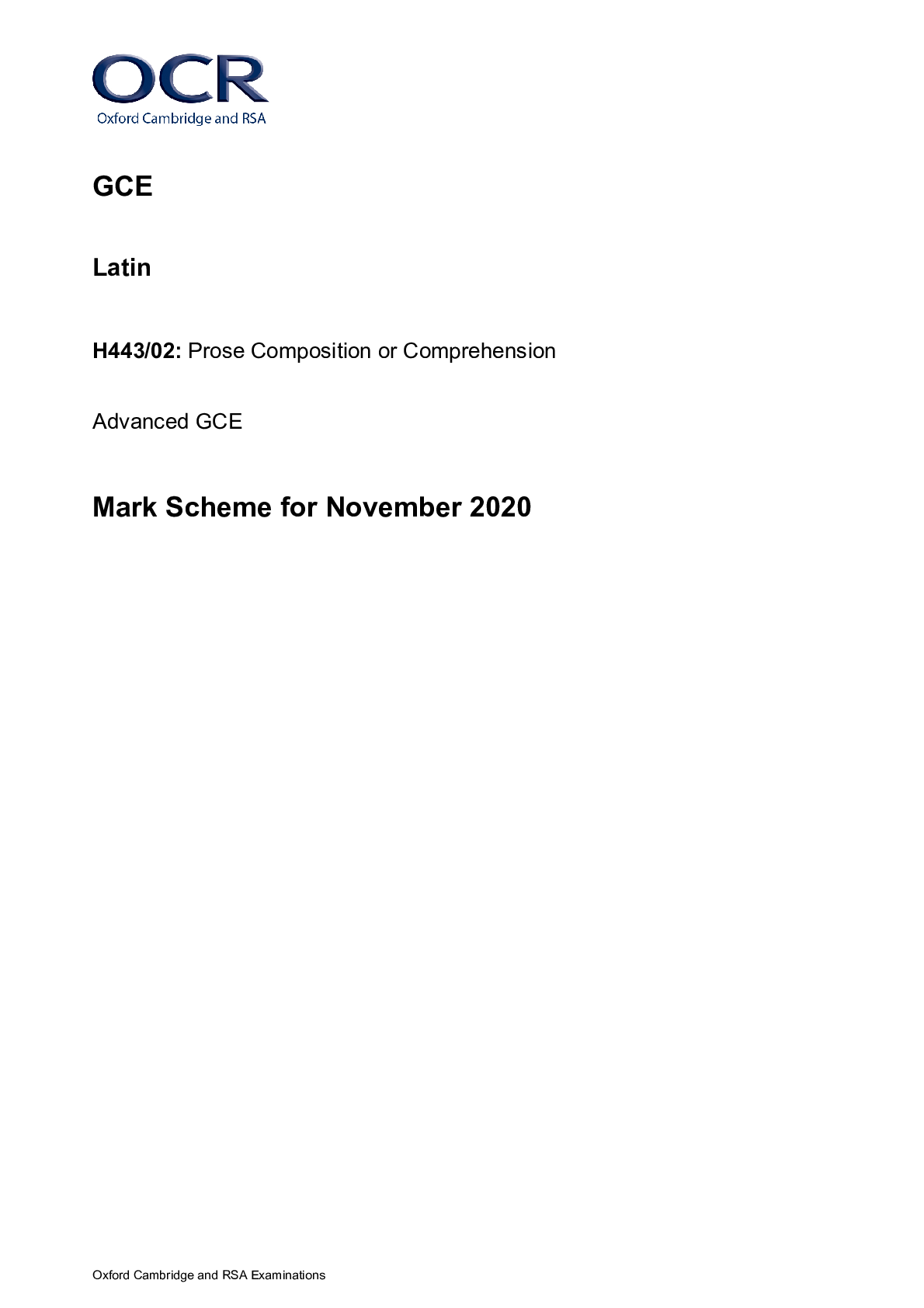History > GCSE MARK SCHEME > GCSE (9–1) Latin J282/03: Prose Literature B General Certificate of Secondary Education Mark Schem (All)
GCSE (9–1) Latin J282/03: Prose Literature B General Certificate of Secondary Education Mark Scheme for November 2020
Document Content and Description Below
GCSE (9–1) Latin J282/03: Prose Literature B General Certificate of Secondary Education Mark Scheme for November 2020 Oxford Cambridge and RSA Examinations GCSE (9–1) Latin J282/03: Pr... ose Literature B General Certificate of Secondary Education Mark Scheme for November 2020Oxford Cambridge and RSA Examinations OCR (Oxford Cambridge and RSA) is a leading UK awarding body, providing a wide range of qualifications to meet the needs of candidates of all ages and abilities. OCR qualifications include AS/A Levels, Diplomas, GCSEs, Cambridge Nationals, Cambridge Technicals, Functional Skills, Key Skills, Entry Level qualifications, NVQs and vocational qualifications in areas such as IT, business, languages, teaching/training, administration and secretarial skills. It is also responsible for developing new specifications to meet national requirements and the needs of students and teachers. OCR is a not-for-profit organisation; any surplus made is invested back into the establishment to help towards the development of qualifications and support, which keep pace with the changing needs of today’s society. This mark scheme is published as an aid to teachers and students, to indicate the requirements of the examination. It shows the basis on which marks were awarded by examiners. It does not indicate the details of the discussions which took place at an examiners’ meeting before marking commenced. All examiners are instructed that alternative correct answers and unexpected approaches in candidates’ scripts must be given marks that fairly reflect the relevant knowledge and skills demonstrated. Mark schemes should be read in conjunction with the published question papers and the report on the examination. © OCR 2020J282/03 Mark Scheme November 2020 Annotations Annotation Meaning Valid style point (8-marker) / AO3 point (10-marker) Unclear/dubious point Benefit of doubt Consequential / repeated error Major error, Incorrect translation or interpretation or factual error Minor error Harmful addition Correct / positive mark / additional evidence (10-marker) Good content point (8-mark & 10-mark question) / 2-mark point in 4-mark AO3 question Weaker content point / 1-mark point in 4-mark AO3 question Omission mark highlight Harmless addition Blank Page – this annotation must be used on all blank pages within an answer booklet (structured or unstructured) and on each page of an additional object where there is no candidate response. Noted but no credit givenJ282/03 Mark Scheme November 2020 Guidance on applying the marking grids for the 5-mark set text translation The mark scheme awards marks for the proportion of sense communicated. If a candidate has communicated the ‘gist’ of a sentence (e.g. they know who has done what to whom) they will score 5, 4 or 3 marks. If they have not understood the basic sense of the sentence, they will score a maximum of 2. A completely correct translation with no omissions or errors will always score 5. The key judgment for a candidate who has demonstrated understanding of the overall meaning of the sentence is whether they should score 5, 4 or 3. This will depend on the gravity of their errors/omissions and may depend on the number of words in the sentence to be translated or the difficulty of the Latin and is usually decided at standardisation after a judgment has been formed about the performance of candidates. The final decisions on what constitute ‘inconsequential’ and ‘more serious errors’ will be made and communicated to assessors via the standardisation process (after full consideration of candidates’ responses) and these decisions will be captured in the final mark scheme for examiners and centres. A word containing more than one error should be treated as a maximum of one serious error. Repeated and consequential vocabulary errors should not be penalised. 5 Perfectly accurate with no errors or omissions, or one inconsequential error. 4 Essentially correct but two inconsequential errors or one more serious error. 3 Overall meaning clear, but more serious errors or omissions. 2 Part correct but with overall sense lacking/unclear 1 No continuous sense; isolated knowledge of vocabulary only.J282/03 Mark Scheme November 2020 Question Answer Mark Guidance 1 (a) (b) Golden/gold (1) Assess against criteria in the 5-mark AO2 grid (see above). nam me priorum nova admonuit, nec refert a qua incipiam. Verania graviter iacebat: ad hanc Regulus venit. primum impudentiam hominis, qui venerit ad aegram, cuius marito inimicissimus, ipsi invisissimus fuerat! Suggested translation: For a/the/this new one/story reminded me of earlier ones, and it does not matter which one I begin with. Verania was lying seriously ill. Regulus came to this woman / her. Firstly (look at) the shamelessness of the man, who came to the sick woman, to whose husband he/Regulus had been most hostile, who had been most hated by Verania herself! AO2 1 AO2 5 The following examples are intended to exemplify what might constitute an inconsequential and more serious error. Allow a range of valid synonyms. Inconsequential error: Omission / mistranslation of nam Omission of me Translation of priorum as singular admonuit: translated as present tense Omission of ipsi fuerat translated as imperfect or perfect Serious error: All other omissions and errors Additions of conjunctions and pronouns that do not affect the meaning, eg. and / that, should not be penalised. Maximum of 4 serious errors for 3 marks More than 4 serious errors for 2 marks For 2 marks: at least 4 correct words (not including proper names) with some continuous meaning over at least two clauses. At least 3 words with the correct meaning for 1 mark 2 (a) Allow any two of the following points: Verania shouts at Regulus / emphatic position of clamat / present historic (1) even though she is dying (moriens) she attacks Regulus verbally (1) she calls him hominem rather than using his name (1) negative words to describe him (scelestum, perfidumque… periurum) / tricolon / tautology / similar negative adjectives (1) she mentions his false oath on his son / she makes it AO2 2 Allow comment on both style and content Allow a maximum of 1 mark for reference to the adjective(s). Quotation of Latin is not required.J282/03 Mark Scheme November 2020 personal by referring to how he treats his own family (1) emphatic use of plus etiam quam (1) Points drawing on text outside the lemma should not be credited. 2 (b) His behaviour / he does this (1) as frequently as wickedly (1) AO3 2 Reference must be made to facit hoc. No credit should be given for ‘he was frequent’. 2 (c) she was old (1), gullible / overly trusting (1), superstitious (1), widowed / without support (1), had no son to be her heir (1), ill/close to death (1) rich (1) AO3 2 Credit any two 3 Answers may include: veteres (centuriones), severos (tribunos): pairing of phrases / pairing of adjectives / emphatic position of negative adjectives to show Piso’s irritating actions. desidiam…licentiam…lascivientes: tricolon to emphasise the range of negative activities / the negative word is placed first in each clause to emphasise the bad things that were happening / use of asyndeton speeds up the narrative making the list seem exhaustive. demovisset…attribuisset…sinebat: a succession of actions of Piso to show the extent of his ill-judged actions nec: negative word at start of clause juxtaposed with Plancina to show she was behaving in a negative way nec...sed: contrast between how Plancina should behave and how she does behave se gerebat ut feminam decebat: tone of disapproval by Tacitus / authorial comment in Agrippinam, in Germanicum: asyndeton / repetition to show that both are being attacked equally contumelias: powerful vocab emphasise inappropriate behaviour of Plancina iaciebat: force of insults is implied metaphor AO3 4 This question focuses on style, not content. If a candidate has made a content point (without an appropriate aspect of style), a mark may be given for the quotation if it appears on the list. If candidates make more than 2 separate points, only award the best two. Accept any two points and award up to two marks each. Assess against point-by-point marking grid below. 2 expresses a valid point based on a relevant aspect of content or aspect of literary style, with accurate, relevant and suitably explained reference to the Latin 1 expresses a valid point, but is not fully supported by an appropriate selection of content or aspect of literary style or reference to the Latin 0 point is not valid, or none are drawnJ282/03 Mark Scheme November 2020 Question Answer Mark Guidance 4 Answers may include: erit vobis: emphatic position to emphasise that the opportunity will be given to them. querendi … invocandi: balanced clauses and repetition of the sound ‘-ndi’ / reference to language from the legal sphere to hammer home his point. decet: emphatic position to emphasise what is proper for them to do. non...sed: contrast of what should not be done and what should be done prosequi...meminisse...exsequi: tricolon of verbs present Germanicus as authoritative quae … quae: balanced phrases / asyndeton to make clear Piso’s wishes and orders. vindicabitis: promotion of the verb / use of future indicative to emphasise the idea of vengeance. vindicabitis vos: alliteration of powerful ‘v’ sound to draw attention to the revenge of his friends. vos...me: contrast emphasising the relationship and expectations between Germanicus and his friends me...meam: polyptoton putting the focus back on Germanicus in person AO3 4 This question focuses on style, not content. If a candidate has made a content point (without an appropriate aspect of style), a mark may be given for the quotation if it appears on the list. If candidates make more than 2 separate points, only award the best two. Accept any two points and award up to two marks each. Assess against point-by-point marking grid below. 2 expresses a valid point based on a relevant aspect of content or aspect of literary style, with accurate, relevant and suitably explained reference to the Latin 1 expresses a valid point, but is not fully supported by an appropriate selection of content or aspect of literary style or reference to the Latin 0 point is not valid, or none are drawnJ282/03 Mark Scheme November 2020 Question Answer Mark Guidance 5 Assess against criteria in the 8-mark AO3 grid (see below). Answers may include: at (Romae): strong contrast between happiness of Plancina and Piso in the previous section and the people’s sorrow here percrebuit: intensifying prefix to show the extend of the rumours percrebuit cunctaque ut ex longinquo aucta: alliteration of harsh sounds represents the chatter of rumour spreading aucta in deterius: comparative indicates the negative spiral of the exaggerations dolor, ira, questus: tricolon with asyndeton to focus on the grief. Three similar nouns are used erumpebant: powerful verb / intensifying ‘e-‘ prefix to show the power of the emotions breaking out. ideo … ideo: conveys the force of the reasons given by the people nimirum: colloquialism reveals the thoughts of the people and adds force Pisoni permissam provinciam: alliteration of ‘p’ suggestive of angry emotions that Piso was entrusted with the province sermones mors Germanici: alliteration of ‘m’ suggests feelings of grief / mourning incendit: use of the metaphor ‘inflamed’ to emphasise the increasing anger of the people adeo … ut: result clause brings into focus the results of the people’s anger. ante … ante: repetition / balanced phrases to show that people’s actions did not wait for the magistrates/senate. desererentur / clauderentur: emphatic word order / parallel phrases / pair of passive verbs to emphasise how everything was deserted uncontrollably AO3 8 For full credit a point must answer the question (i.e. plausible explanation of how the point makes the scene vivid and dramatic), must quote from the Latin and must give a clear indication of the meaning of the Latin. Allow relevant content or style points. Do not give full credit for undeveloped points referring to, e.g., “harsh consonants”, “sibilance”, “promotion”, “asyndeton”, “short phrases”. Give partial credit for a second point based on the same Latin quotation.J282/03 Mark Scheme November 2020 ubique silentium et gemitus: short phrase / ellipsis of verb to bring into focus the raw grief / contrast between silence and loud groaning quamquam…altius: comparative adverb / contrast between the outward signs of grief and the grief that was felt in their hearts. Guidance on applying the marking grids for the 8-mark extended response This question focuses on candidates’ ability to select relevant examples of content and literary style and to structure an answer around these examples to express relevant points. Therefore candidates will be assessed on the quality of the points made and the range and quality of the examples they have selected from the passage. Examiners must use a best fit approach to the marking grid. Where there are both strengths and weaknesses in a particular response, examiners must carefully consider which level is the best fit for the performance overall. 8-mark grid for the extended response question AO3 = 8 marks = Analyse, evaluate and respond to literature Level Marks Description 4 7-8 • very good engagement with the question • expresses a range of relevant points, with good development, drawn on a range of well selected aspects of content and features of literary style, with a good range of appropriate quotation with well thought out discussion The response is logically structured, with a well-developed, coherent line of reasoning. 3 5-6 • good engagement with the question • expresses a range of sound points, with some development, drawn on a range of relevant aspects of content and features of literary style, with a range of appropriate quotation, with sound discussion The response is well structured with a clear line of reasoning. 2 3-4 • some engagement with the question • expresses some points drawn on a limited range of aspects of content and/or features of literary style, with some appropriate quotation and some discussion The response presents a line of reasoning which is mostly relevant but may lack structure 1 1-2 • little engagement with the question • expresses points which are of little relevance and are supported with little evidence from the set text The information is communicated in an unstructured way. 0 = No response or no response worthy of creditJ282/03 Mark Scheme November 2020 Question Answer Mark Guidance 6 (a) Piso was a friend / representative (1) of Tiberius’ father / Augustus (1) AO2 2 Allow “commander” / “envoy” / “ambassador” for legatus 6 (b) Allow either of the following: To manage affairs in the East (1) As an assistant / helper to Germanicus (1) AO2 1 Allow Orient 6 (c) Whether Piso harassed Germanicus / the young man (because of arrogance and rivalry) (1) rejoiced at his death (1) or destroyed / killed him (by some crime / criminally) (1) AO2 3 7 (a) his hatred of Germanicus (1) his eagerness for revolution (1) AO2 2 Allow “new state of affairs / political things” for rerum novarum. Do not allow things / business 7 (b) Curses / spells (1) poison (1) AO2 2 7 (c) Latin word: nefandas (1) English word: wicked / evil / unspeakable / unholy (1) AO2 2 Do not allow any credit for a correct translation of an incorrect Latin wordJ282/03 Mark Scheme November 2020 Question Answer Mark Guidance 8 ‘Tacitus portrays Germanicus as good and Piso as evil’. To what extent do you agree with this statement? You should support your answer with a range of references from the Tacitus text you have read, and you may include passages printed on the question paper. Assess against criteria in the 10-mark grid (see below). Arguments may include (AO3): Possible supporting evidence from the prescribed text (AO2): Germanicus: • Germanicus was dutiful and attended to his public duties before his private problems o he attended to the Armenians before his own differences with Piso and Plancina • even when he suspected Piso was poisoning him, he was restrained o when he was suspicious of Piso he broke off his friendship with him • he was noble and dignified at the end and tried to comfort his friends o he made a noble and restrained speech on his death bed • he wanted revenge on Piso – this was seen in a more positive way in Roman times perhaps than today o he did not want pity, he wanted revenge • he and his wife Agrippina were very popular and respected with Romans as well as foreigners o foreigners and Romans all grieved when he died 10 made up of AO2=5 AO3=5J282/03 Mark Scheme November 2020 • he was friendly towards allies o this was why they were so sad when they heard about his death • he showed mercy towards enemies o hence they were sad when he died • he was handsome and descended from a distinguished family o he was described in a traditionally noble way • he had a beautiful marriage o Germanicus and his wife were equally likeable and their marriage was perfect Piso: • he associated with the worst people in society o he helped the most disreputable of the soldiers • he was untrustworthy / dishonest o he bribed the soldiers • he was a poor leader who did not manage his province well o he allowed idleness among the soldiers, rampaging through the fields • his wife also seemed to have many negative characteristics and this made you think worse of Piso o Plancina did not behave as is proper for a lady and insulted Agrippina and Germanicus • Piso was associated black magic and evil religious rites o inscribed lead tablets, half-burned cremated remains and things dedicated to the gods of the Underworld were attributed to Germanicus • Piso and Plancina were inappropriate and excessiveJ282/03 Mark Scheme November 2020 o Piso rejoiced at the death of Germanicus excessively and sacrificed victims in temples at the news • they did not respect the mourning of Germanicus o Piso rejoiced and his wife exchanged her mourning dress at the time of Germanicus’ death • Piso was noble and had imperial links o Piso was a friend and representative of Tiberius’ father • Piso was probably responsible for the death of Germanicus o this was what he was accused of, although it was the only charge that could not be proved in court • Piso was eager for revolution and urged the legions to revolt o this was what he was accused of in court • Unpopular o the people crowded around the court house and threatened violence if Piso was found innocent • Unsupported by his wife in the end o even his wife Plancina deserted Piso in the end • Dignified end or perhaps it was cowardly o Piso’s suicide was described rather briefly by Tacitus. He appeared almost dignified and noble in his last hoursJ282/03 Mark Scheme November 2020 Guidance on applying the marking grids for the 10-mark extended response Two Assessment Objectives are being assessed in this question – AO2 (Demonstrate knowledge and understanding of literature) and AO3 (Analyse, evaluate and respond to literature). The two Assessment Objectives are equally weighted. Examiners must use a best fit approach to the marking grid. Where there are both strengths and weaknesses in a particular response, particularly imbalanced responses in terms of the assessment objectives, examiners must carefully consider which level is the best fit for the performance overall. For example, you should not be able to achieve a mark of 8 made up of AO2 = 6 and AO3 = 2. Responses are credited for AO2 for the detail and accuracy of the knowledge of the set text they deploy and for their understanding of the set text(s). Responses are credited for AO3 for how well the response addresses the question, for candidates selecting relevant examples from the set texts they have studied and drawing and expressing conclusions based on the selected examples in relation to the question posed. Candidates will be assessed on the quality of the conclusions and points they argue and the range and quality of the examples they have selected. For example, in relation to the question ‘How successfully do Tacitus and Cicero turn the reader against Agrippina and Sassia?’, details of Agrippina’s pretence of grief and an understanding that this was in reality an effort to prevent help being brought to Claudius would be evidence of AO2 whilst concluding that this clearly demonstrates Agrippina’s scheming nature and thus helps turn the reader against her would be evidence of AO3. 10-mark grid for the extended response question AO2 = 5 marks = Demonstrate knowledge and understanding of literature AO3 = 5 marks = Analyse, evaluate and respond to literature Level Marks Characteristics of performance 5 9-10 • detailed knowledge and excellent understanding of the set text (AO2) • well-argued response to the question which is supported by a range of well-selected examples from the set text (AO3) The response is logically structured, with a well-developed, sustained and coherent line of reasoning. 4 7-8 • good knowledge and sound understanding of the set text (AO2) • a good response to the question which is supported by some well-selected examples from the set text (AO3) The response is logically structured, with a well-developed and clear line of reasoning. 3 5-6 • some knowledge and understanding of the set text (AO2) • a reasonable response to the question which is supported by some examples from the set text (AO3) The response presents a line of reasoning which is mostly relevant and has some structure. 2 3-4 • limited knowledge and understanding of the set text (AO2) • a limited response to the question which is occasional supported by reference to the set text (AO3) The response presents a line of reasoning but may lack structure. 1 1-2 • very limited knowledge and understanding of the set text (AO2) • a very limited response to the question with very limited reference to the set text (AO3) The information is communicated in an unstructured way 0= No response or no response worthy of creditOCR (Oxford Cambridge and RSA Examinations) The Triangle Building Shaftesbury Road Cambridge CB2 8EA [Show More]
Last updated: 1 year ago
Preview 1 out of 15 pages
Instant download

Buy this document to get the full access instantly
Instant Download Access after purchase
Add to cartInstant download
Reviews( 0 )
Document information
Connected school, study & course
About the document
Uploaded On
Oct 07, 2022
Number of pages
15
Written in
Additional information
This document has been written for:
Uploaded
Oct 07, 2022
Downloads
0
Views
59

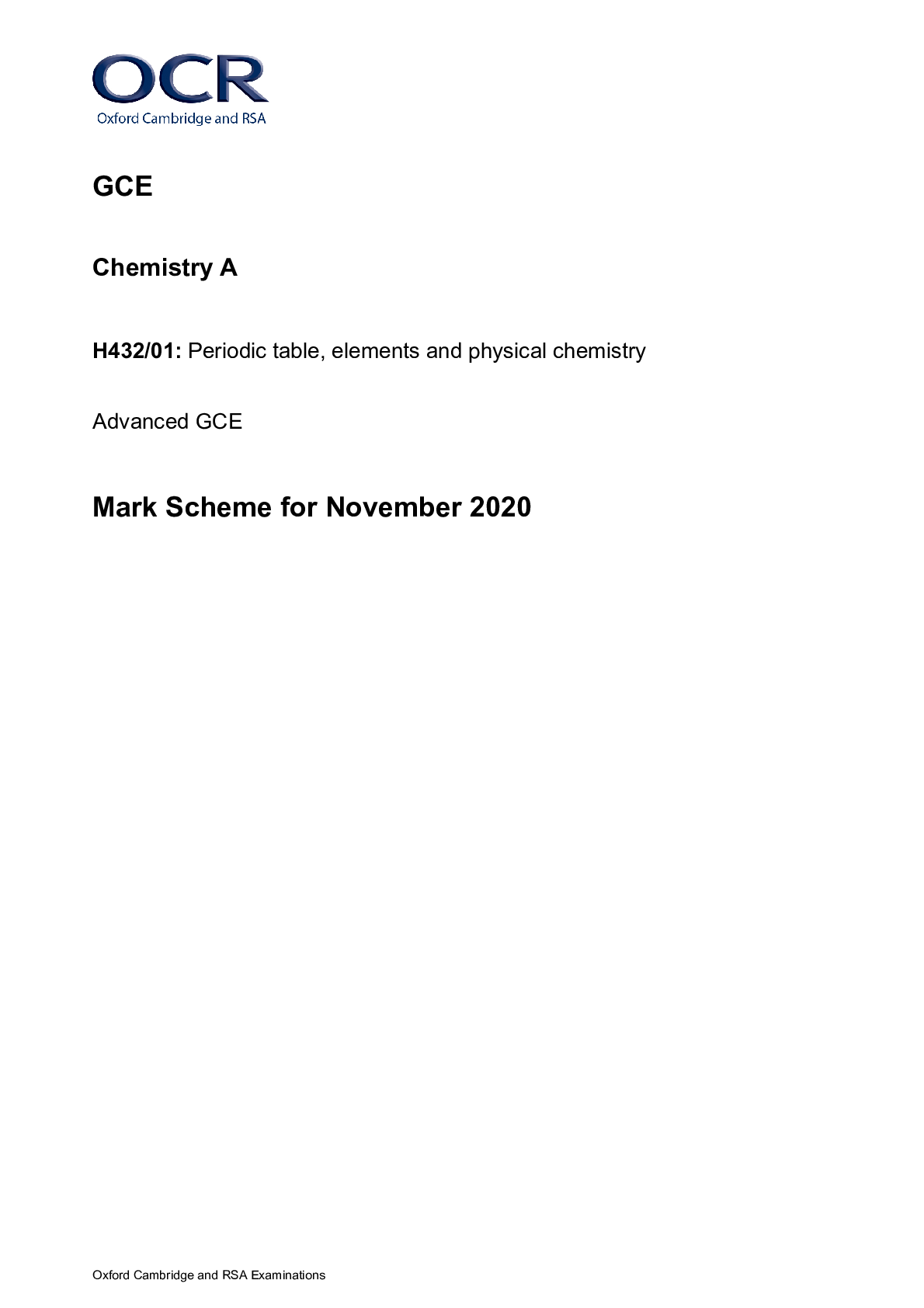

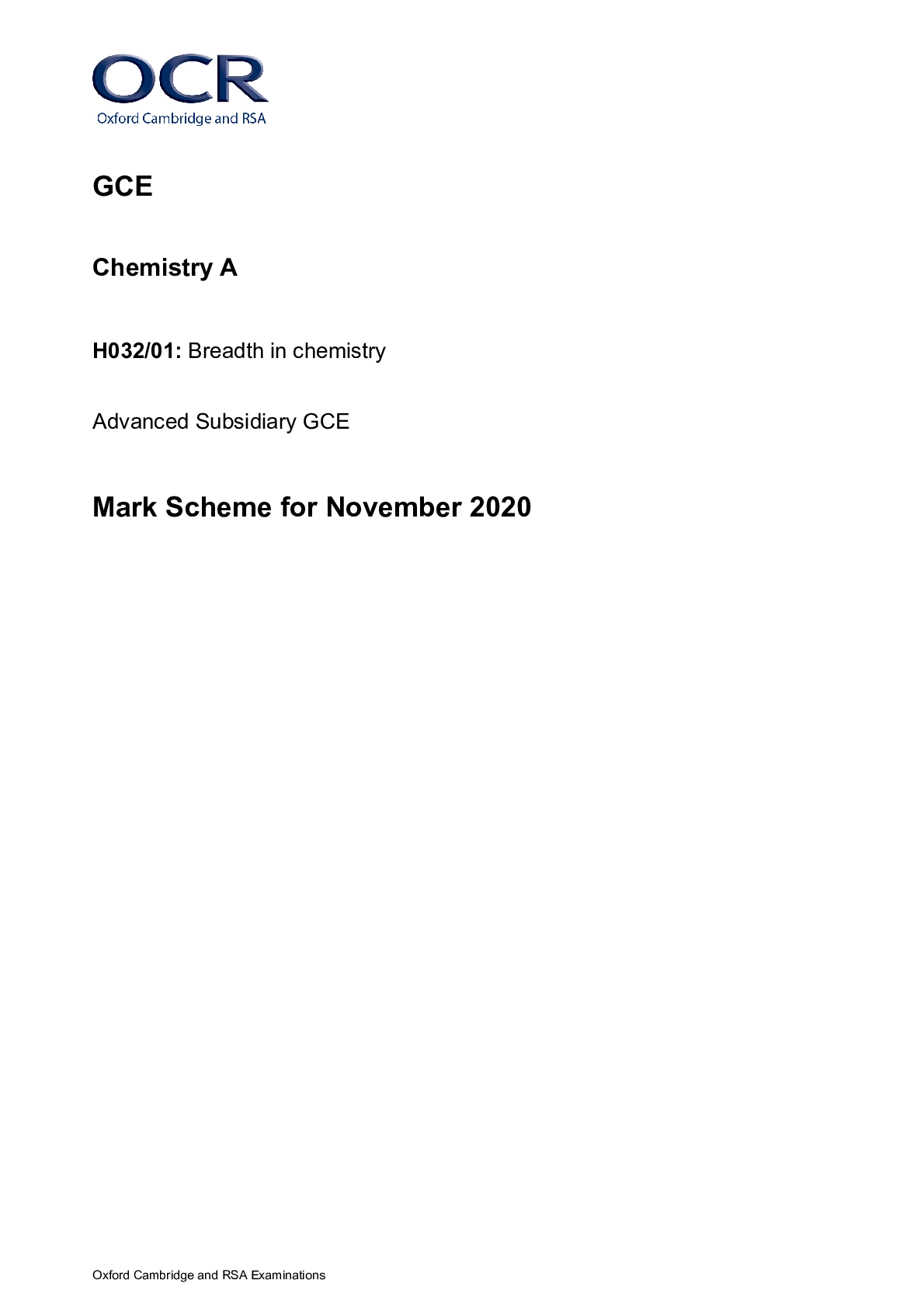


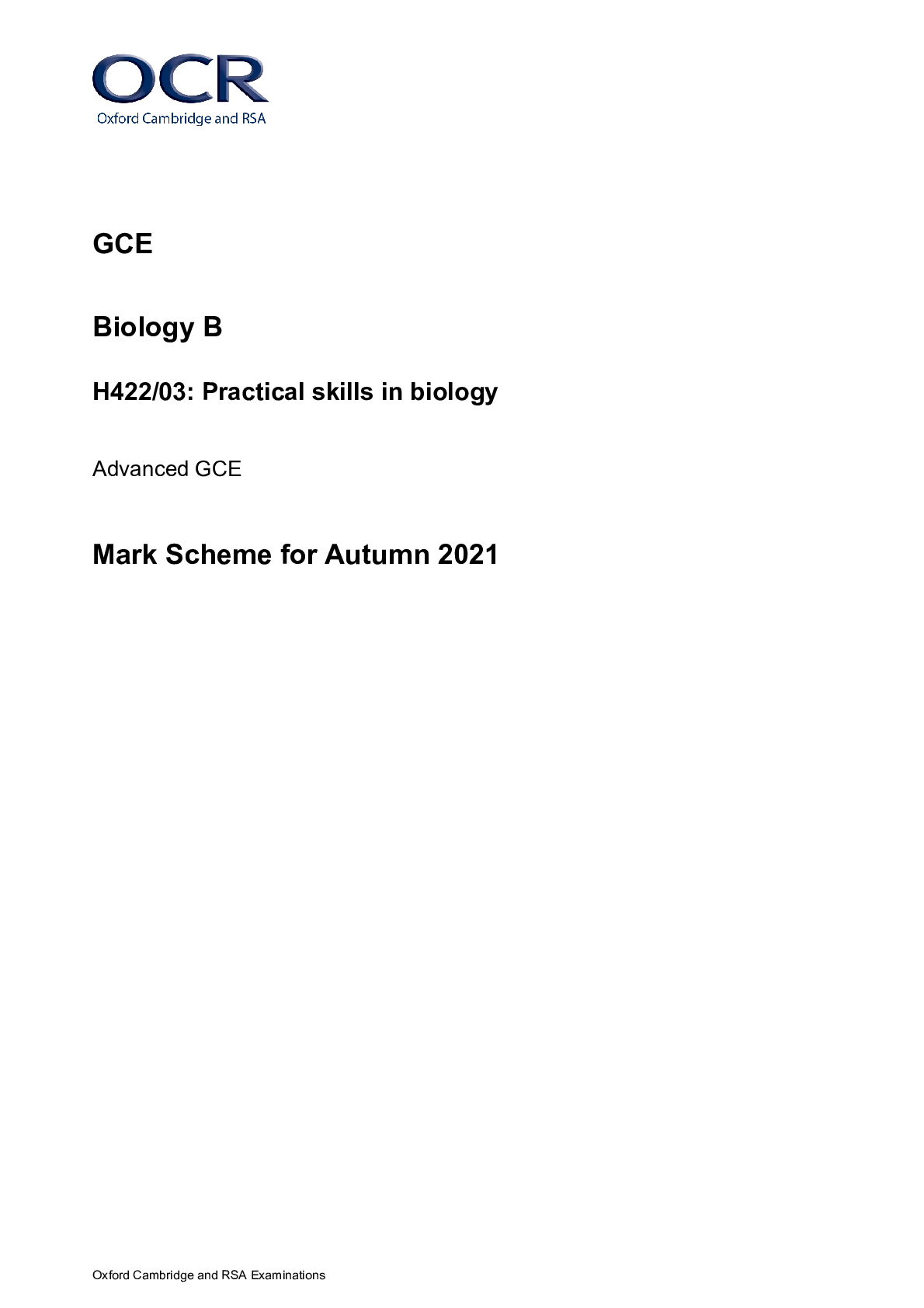

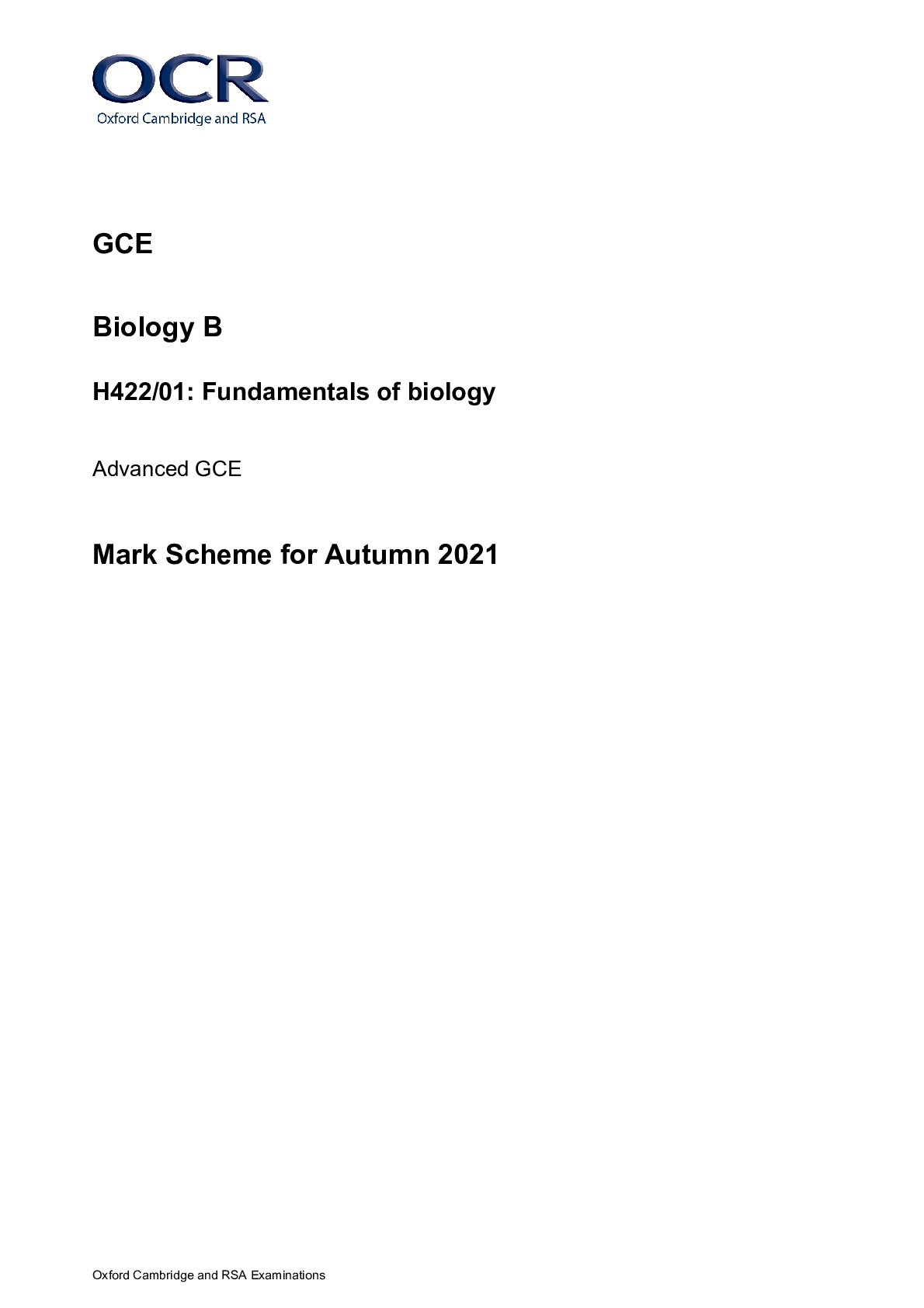
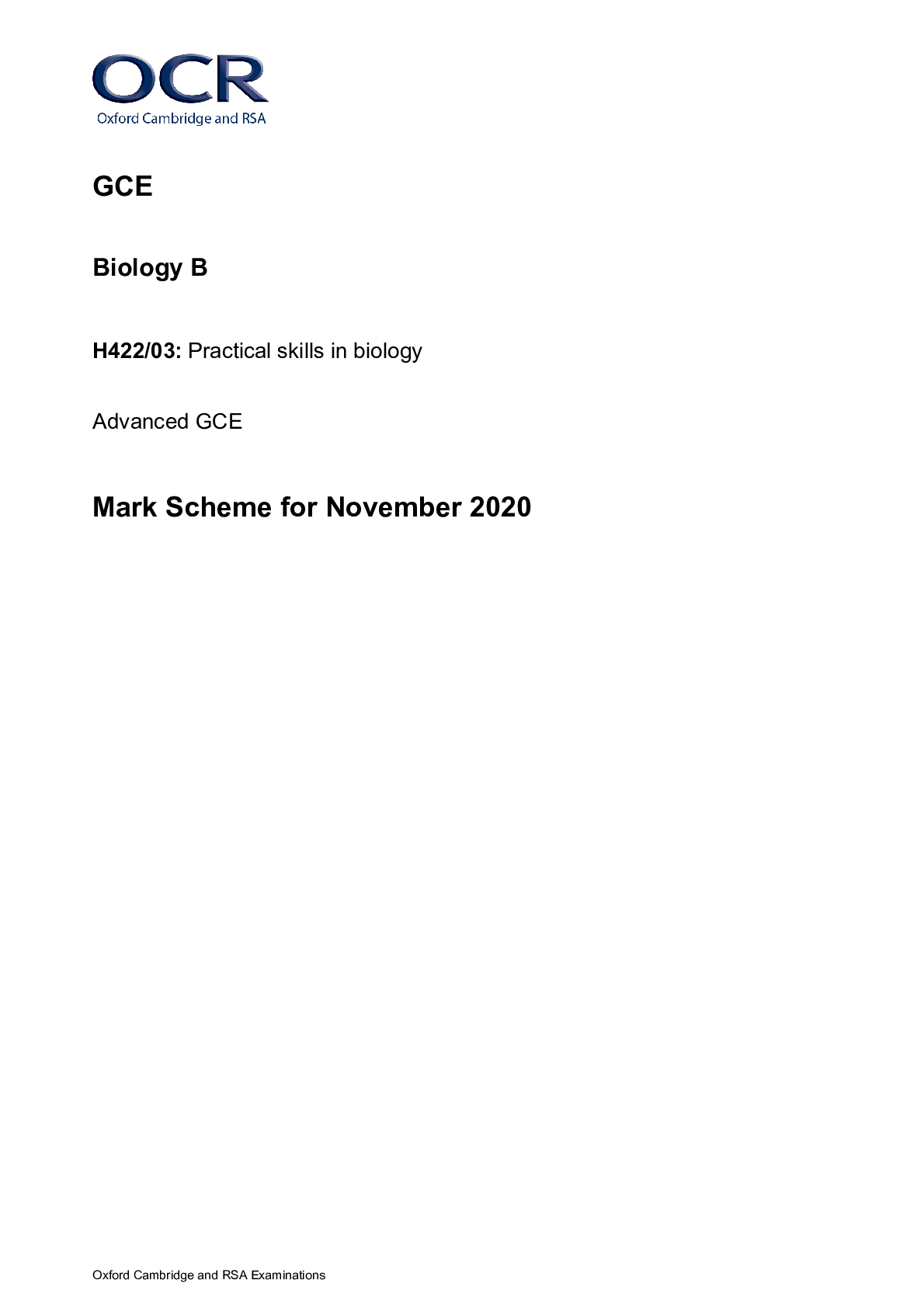
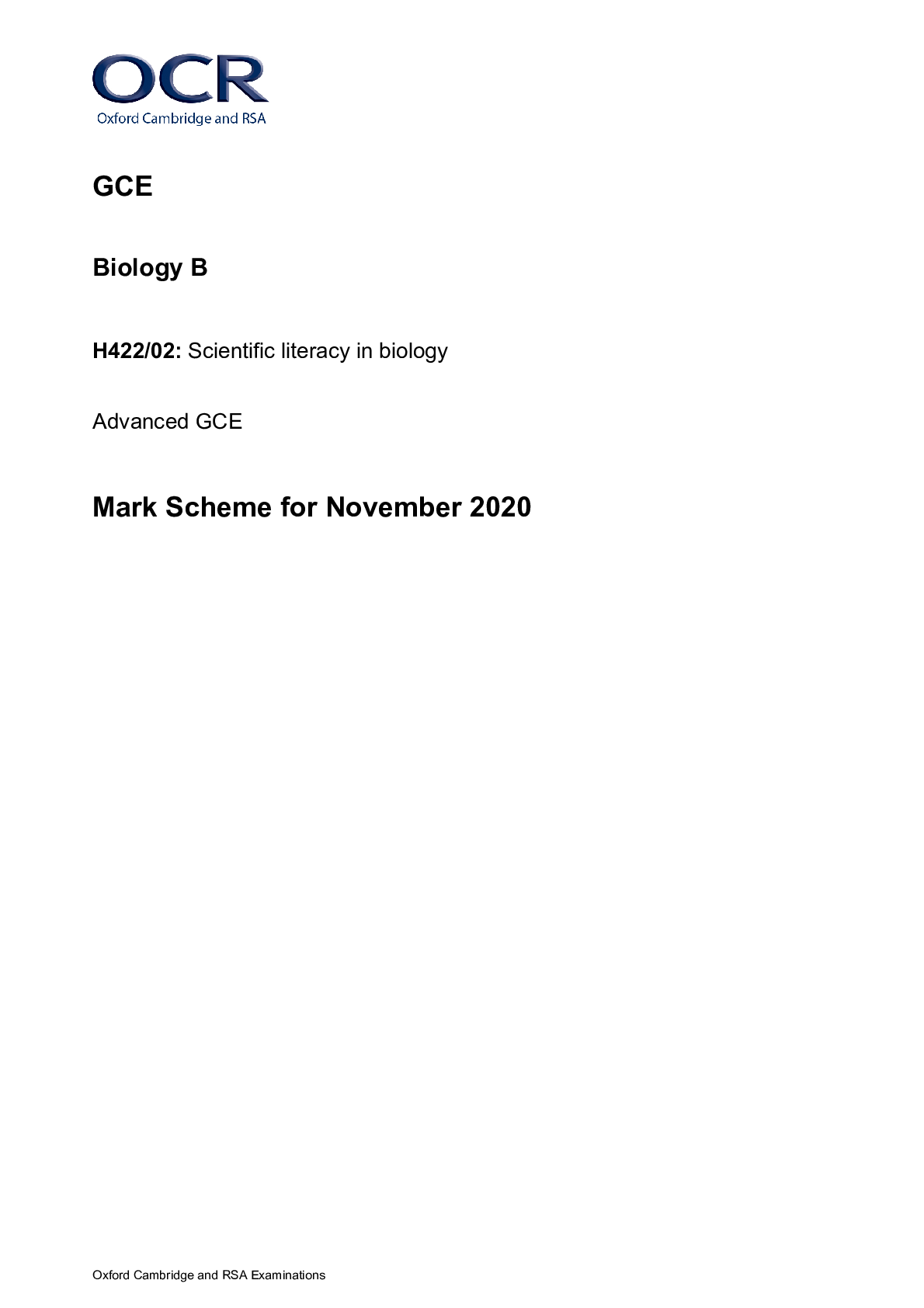
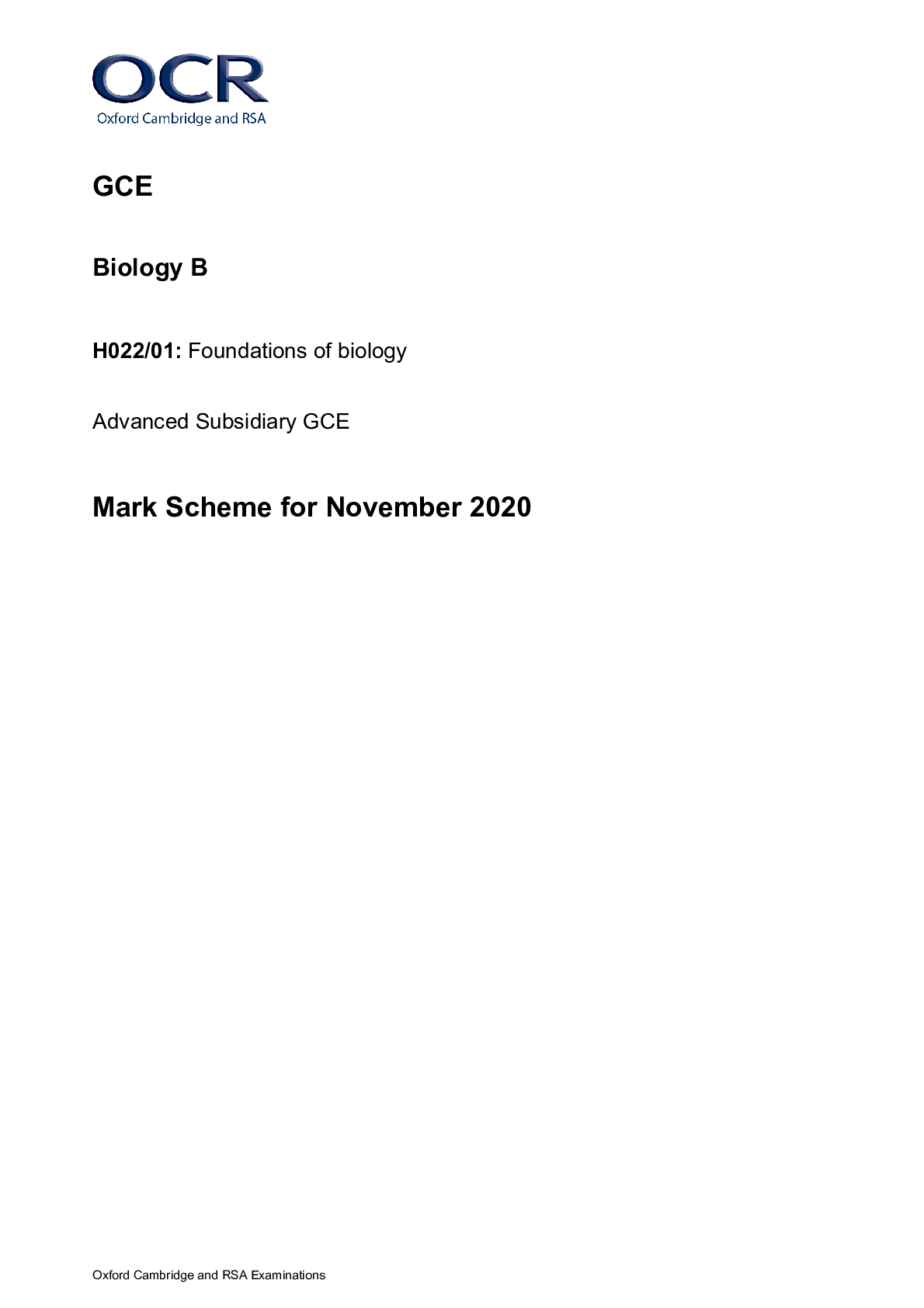



.png)
